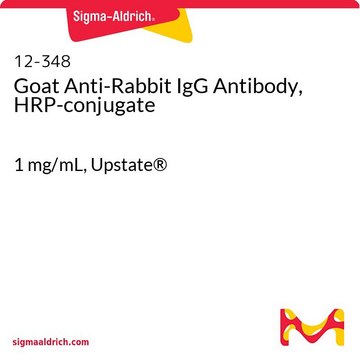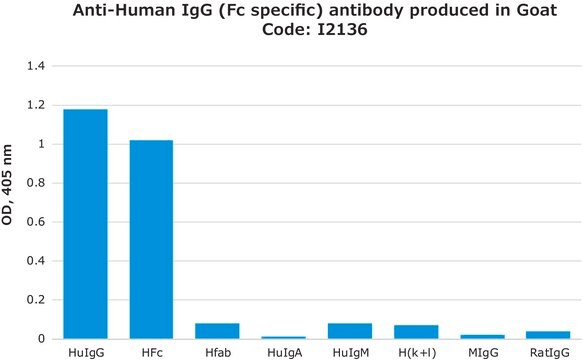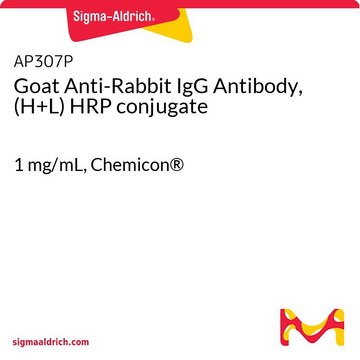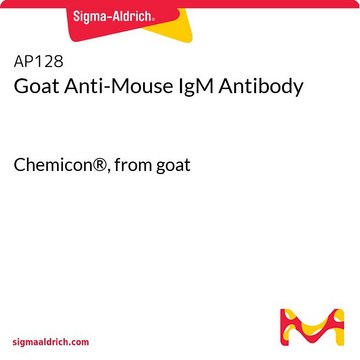AP127
Goat Anti-Mouse IgG Antibody, Fc
2.4 mg/mL, Chemicon®
Zaloguj sięWyświetlanie cen organizacyjnych i kontraktowych
About This Item
Kod UNSPSC:
12352203
eCl@ss:
32160702
NACRES:
NA.46
Polecane produkty
pochodzenie biologiczne
goat
Poziom jakości
białko sprzężone
unconjugated
forma przeciwciała
affinity purified immunoglobulin
klon
polyclonal
reaktywność gatunkowa
mouse
producent / nazwa handlowa
Chemicon®
stężenie
2.4 mg/mL
metody
ELISA: suitable
immunoprecipitation (IP): suitable
western blot: suitable
Warunki transportu
wet ice
docelowa modyfikacja potranslacyjna
unmodified
Opis ogólny
Immunoglobulin G (IgG), is one of the most abundant proteins in human serum with normal levels between 8-17 mg/mL in adult blood. IgG is important for our defence against microorganisms and the molecules are produced by B lymphocytes as a part of our adaptive immune response. The IgG molecule has two separate functions; to bind to the pathogen that elicited the response and to recruit other cells and molecules to destroy the antigen. The variability of the IgG pool is generated by somatic recombination and the number of specificities in an individual at a given time point is estimated to be 1011 variants.
Zastosowanie
Detect Mouse IgG using this Goat anti-Mouse IgG Antibody, Fc validated for use in ELISA, IP & WB.
Postać fizyczna
Affinity purified immunoglobulin. Liquid. Buffer = 0.01% Sodium Phosphate, 0.25 M NaCl, pH 7.6
Przechowywanie i stabilność
Store at +2-8°C in undiluted aliquots for up to six months, sterile conditions.
Informacje prawne
CHEMICON is a registered trademark of Merck KGaA, Darmstadt, Germany
Ta strona może zawierać tekst przetłumaczony maszynowo.
Kod klasy składowania
12 - Non Combustible Liquids
Klasa zagrożenia wodnego (WGK)
WGK 2
Temperatura zapłonu (°F)
Not applicable
Temperatura zapłonu (°C)
Not applicable
Certyfikaty analizy (CoA)
Poszukaj Certyfikaty analizy (CoA), wpisując numer partii/serii produktów. Numery serii i partii można znaleźć na etykiecie produktu po słowach „seria” lub „partia”.
Masz już ten produkt?
Dokumenty związane z niedawno zakupionymi produktami zostały zamieszczone w Bibliotece dokumentów.
Conformation-dependent high-affinity monoclonal antibodies to prion proteins.
Larry H Stanker,Ana V Serban,Elisa Cleveland,Robert Hnasko,Azucena Lemus,Jiri Safar et al.
Journal of immunology (Baltimore, Md. : 1950) (1950)
Different rates of glycolysis affect glycolytic activities and protein properties in turkey breast muscle.
S Eadmusik,C Molette,H Remignon,X Fernandez
Animal : An International Journal of Animal Bioscience null
Larry H Stanker et al.
Toxins, 5(11), 2212-2226 (2013-11-21)
Botulism is a serious foodborne neuroparalytic disease, caused by botulinum neurotoxin (BoNT), produced by the anaerobic bacterium Clostridium botulinum. Seven toxin serotypes (A-H) have been described. The majority of human cases of botulism are caused by serotypes A and B
Miles C Scotcher et al.
PloS one, 5(6), e11047-e11047 (2010-06-16)
Botulinum neurotoxin (BoNT), the causative agent of botulism, a serious neuroparylatic disease, is produced by the anaerobic bacterium Clostridium botulinum and consists of a family of seven serotypes (A-H). We previously reported production of high-affinity monoclonal antibodies to BoNT serotype
Nasz zespół naukowców ma doświadczenie we wszystkich obszarach badań, w tym w naukach przyrodniczych, materiałoznawstwie, syntezie chemicznej, chromatografii, analityce i wielu innych dziedzinach.
Skontaktuj się z zespołem ds. pomocy technicznej








